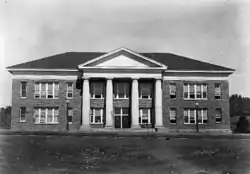Northern Arizona University
Northern Arizona University (NAU) is a public research university with its main campus in Flagstaff, Arizona.[8] Governed by the Arizona Board of Regents and accredited by the Higher Learning Commission, the university offers more than 150 baccalaureate programs and more than 100 graduate degree programs. It is classified among "R2: Doctoral Universities – High research activity".[9]
 | |
| Type | Public research university |
|---|---|
| Established | 1899[1] |
Parent institution | Arizona Board of Regents |
Academic affiliation | Space-grant |
| Endowment | $192.6 million (2019)[2] |
| President | Rita Hartung Cheng[3] |
| Provost | Diane Stearns[4] |
Academic staff | 1,151 (full time)[5] |
| Students | 29,569[6] |
| Undergraduates | 25,230[6] |
| Postgraduates | 4,339[6] |
| Location | , , United States |
| Campus | Small city 707.62 acres (2.8636 km2) |
| Colors | Blue and gold[7] |
| Nickname | Lumberjacks |
Sporting affiliations | NCAA Division I |
| Mascot | Louie the Lumberjack |
| Website | nau |
 | |
As of fall 2020, 29,569 students were enrolled, 21,495 at the Flagstaff campus.[10] The average cost of tuition and fees for a full-time, Arizona resident undergraduate student for two semesters was $11,896 in 2020,[11] and out-of-state undergraduates paid an estimated $26,642.[12] NAU also participates in the Western Undergraduate Exchange Program, which offers lower tuition rates for students from the Western United States. For 2020–21, WUE tuition and fees are $17,221.[13] NAU offers Flagstaff undergraduate students the Pledge Program, which guarantees the same tuition rate for four years.
History

Initially named the Northern Arizona Normal School, the institution opened on September 11, 1899, with 23 students, two faculty members—one, Almon Nicholas Taylor, who was also the school president—and "two copies of Webster's International Dictionary bound in sheepskin" as teaching resources.[14] The first graduating class, in 1901, consisted of four women who received credentials to teach in the Arizona Territory. In 1925, the Arizona State Legislature allowed the school, which was then called the Northern Arizona State Teachers College (ASTC), to grant bachelor of education degrees. In 1929, the school became Arizona State Teachers College at Flagstaff.[15]
Also in 1929, the Great Depression struck the nation, and the ASTC found new meaning in community outreach. Rather than collapsing, the school endured through the depression. In fact, Grady Gammage, the school president at the time, described higher education as "a 'depression industry' that fared well in hard times." Despite financial difficulties, enrollment increased from 321 students to 535 students between 1930 and 1940, and graduate work was introduced in 1937.[16]
ASTC provided an education during economically trying times, often creating jobs to help students afford their education; they worked in the school-owned dairy farm, in the campus kitchen and dining hall, and as newspaper deliverers. The self-sufficiency of the college helped conserve monetary resources, and it was a major contributor to the local economy of the surrounding Flagstaff community, injecting almost a half million dollars in 1938.[17]
ASTC was known for its diverse student body and ethnic tolerance. In fact, the first Hopi to receive a college degree was Ida Mae Fredericks in 1939.[17] Students came from rural farms, mining families, the East Coast, and points between. During the depression, fraternities and clubs sprang up, reflecting the diversity of background and interests.
Enrollment dropped sharply at the beginning of World War II, dropping to 161 in 1945.[18] During this time, ASTC became a Navy V-12 program training site.[19] However, the end of World War II brought increased enrollment as returning veterans continued their education.
The end of the war also expanded programs beyond teaching degrees, especially in the fields of art and science. To reflect this growth, the school changed its name to Arizona State College at Flagstaff in 1945 and, in 1958, became Arizona State College after the former Arizona State College at Tempe became Arizona State University. Also in 1958, the forestry program was introduced. With further growth over the next two decades, the Arizona Board of Regents granted Arizona State College university status as Northern Arizona University in 1966.[15]
Campuses
Flagstaff campus
Set across 829 forested acres, the Flagstaff campus houses academic, administrative, and residential buildings. At 6,950 feet (2,120 m) above sea level, NAU is one of the highest-elevation, four-year college campuses in the country. The main campus is surrounded by the largest contiguous ponderosa pine forest in the world[20] and enjoys a four-season climate, with an average annual snowfall of 260 inches. Winter skiing is accessible at Arizona Snowbowl, an alpine ski resort located on the San Francisco Peaks, 7 miles (11 km) northwest of town and the Grand Canyon and Sedona are short drives away.[21] Flagstaff is regularly ranked among the best college towns in the United States.[22]
For many years, the university has prioritized sustainability initiatives,[23] and campus-wide programs and resources encourage the entire university community to get involved with sustainability efforts. There are more than a dozen LEED (Leadership in Energy and Environmental Design)-certified buildings on campus and all new construction must meet strict LEED standards. Dining services and facilities contribute to a composting initiative, collecting more than 300,000 pounds of material each year, which prevents 250 metric tons of carbon dioxide from entering the atmosphere. Much of the campus uses renewable wind and solar technologies and the university is investigating opportunities to utilize the vast ponderosa pine forests around campus for biomass electricity or heat production.
Statewide campuses and NAU Online
In addition to the more than 21,000 students who study on the Flagstaff campus, to provide access and affordability to all Arizona residents NAU currently serves another 8,000 students online and statewide. NAU offers more than 130 accredited degree programs at more than 20 statewide campuses.[24] NAU also has partnerships with community colleges and NAU–Yavapai, a collaboration with Yavapai College in Prescott Valley, Arizona. The university's oldest branch campus, and the largest, is NAU Yuma.
NAU Online[25] has two paths to degrees: traditional online and competency-based.
- Traditional online courses conform to the regular semester schedule and tuition is based on credit hours.
- The competency-based online model has weekly start dates and students work at their own pace. Payment for competency-based learning is based on a six-month flat subscription rate.
Academics
Fall Freshman Statistics[26][27][28][29][30][31]
| 2019 | 2018 | 2017 | 2016 | 2015 | |
|---|---|---|---|---|---|
| Applicants | 36,855 | 36,831 | 36.875 | 36,511 | 31,995 |
| Admits | 31,312 | 30,428 | 29,812 | 28,495 | 20,727 |
| % Admitted | 84.95 | 82.61 | 80.85 | 78.04 | 64.78 |
| Enrolled | 3,395 | 3,668 | 3,872 | 5,607 | 3,872 |
| Avg Freshman GPA | 3.64 | 3.61 | 3.60 | 3.60 | 3.40 |
| Avg ACT Composite | 23 | 23 | 23 | 23 | 23 |
Across seven colleges, NAU offers more than 150 baccalaureate programs, more than 80 master's degree programs, and about 25 doctoral programs, along with 40 undergraduate and 25 graduate certificates.
In the fall of 2020, the top undergraduate academic degree plans by enrollment were Nursing, Biomedical Science, Criminology and Criminal Justice, Elementary Education, and Psychological Sciences.[10]
College of Arts and Letters
The College of Arts and Letters houses numerous departments, including:
- School of Art
- Comparative Cultural Studies
- English
- Global Languages and Cultures
- History
- Philosophy
- School of Music
- Theatre
The college also oversees the NAU Art Museum, Martin-Springer Institute (promoting lessons of the Holocaust), Northern Arizona Writing Project, Ardrey Memorial Auditorium, and Ashurst Hall. The College of Arts and Letters Film Series has provided quality classic films to the NAU and Flagstaff community for a decade, and has recently established the NAU International Film Series. CAL is also home to NAU's doctoral program in Applied Linguistics. Department faculty and students share their scholarly work and artistic achievement through more than 300 performances, lectures, films, and exhibitions annually.[32]
| University rankings | |
|---|---|
| National | |
| ARWU[33] | 134-154 |
| Forbes[34] | 515 |
| THE/WSJ[35] | 501-600 |
| U.S. News & World Report[36] | 284 |
| Washington Monthly[37] | 192 |
| Global | |
| ARWU[38] | 501-600 |
| THE[39] | 501-600 |
| U.S. News & World Report[40] | 688 |
College of Education
The College of Education is a cornerstone of NAU academics, with bachelor's, master's, and doctoral programs available. Programs focus on early childhood, elementary, secondary, and higher education. Fields of study include:
- Educational Leadership
- Educational Psychology
- Educational Specialties (e.g., bilingual and multicultural education, career and technical education, educational technology, and special education)
- Teaching and Learning[41]
The college also houses the Diné Dual Language Teachers Professional Development Project that works with teachers with proficiency in the Diné (Navajo) language and high academic achievement to meet licensing requirements for teachers who work in language instruction education programs.
College of Engineering, Informatics, and Applied Sciences
The College of Engineering, Informatics, and Applied Sciences is NAU's newest college. Within CEIAS are 19 undergraduate majors, 5 minors, 13 master's, and 5 doctoral programs. The college includes schools and departments[42] for:
- Applied Physics and Materials Science
- Civil and Environmental Engineering
- Construction Management
- Mechanical Engineering
- School of Informatics, Computing, and Cyber Systems
Students have access to numerous research labs including:[43]
- Center for Ecosystem Science and Society
- Center for Health Equity Research
- Center for Materials Interfaces in Research and Applications
- Merriam Powell Center for Environmental Research
- Pathogen and Microbiome Institute
College of the Environment, Forestry, and Natural Sciences
The College of the Environment, Forestry, and Natural Sciences[44] has undergraduate and graduate programs that integrate science and mathematics through the creative application of knowledge. Departments include:
- Astronomy and Planetary Science
- Biological Sciences
- Center for Science Teaching and Learning
- Chemistry and Biochemistry
- School of Earth and Sustainability
- School of Forestry
- Mathematics and Statistics
More than 30 university-funded research institutes and centers are available to faculty and students, including:
- Center for Ecosystem Science and Society
- Colorado Plateau Biodiversity Center
- Ecological Restoration Institute
- National Institute for Climate Change Research
College of Health and Human Services
The College of Health and Human Services[45] prepares students to become excellent health professionals, and to provide service to improve the health and well-being of the communities served, particularly Arizona residents, Native Americans, and individuals considered disadvantaged. The college's departments—offering bachelor's, master's, and doctoral degrees—include:
- Athletic Training
- Communication Sciences and Disorders
- Dental Hygiene
- Health Sciences
- Nursing
- Occupational Therapy
- Physical Therapy
- Physician Assistant Studies
The College of Health and Human Services offers several programs at the Phoenix Biomedical Campus,[46] a state-of-the-art facility on 30 acres in downtown Phoenix that includes more than six million square feet of research, academic, and clinical facilities for students earning advanced degrees in medical professions.
College of Social and Behavioral Sciences
The College of Social and Behavioral Sciences[47] offers a wide array of social science and related professional degree programs, including:
- Anthropology
- Applied Indigenous Studies
- Communication
- Criminology and Criminal Justice
- Ethnic Studies
- Geography, Planning, and Recreation
- Politics and International Affairs
- Psychological Sciences
- Sociology
- Social Work
- Sustainable Communities
- University Studies
- Women's and Gender Studies
The college also houses the Civic Service Institute that connects students, older adults, and other community members to national service volunteer opportunities within their communities. The Institute for Human Development fosters the development of attitudes that promote the public's appreciation and value of individuals with disabilities.
The W. A. Franke College of Business
The W. A. Franke College of Business's[48] primary focus is undergraduate education, but it also offers master's-level education and research opportunities. Businessman Bill Franke's commitment of $25 million resulted in the renaming of the college in his honor. The W. A. Franke College of Business was fully reaccredited in fall 2008 by the national accrediting body, the Association to Advance Collegiate Schools of Business – AACSB International. NAU's program is one of about 500 accredited programs among the more than 1,000 throughout the nation. The college is based in a 111,000-square-foot (10,300 m2), LEED-certified building.[49] It is divided into two divisions:
Business Division
- Accounting
- Economics
- Finance
- Information Systems
- Management
- Marketing
- MBA
School of Hotel and Restaurant Management
- Hotel and Restaurant Management – this program is ranked 14th on the Best Hospitality and Hotel Management Schools in the World list by CEOWorld Magazine.[50]
Honors College
NAU is home to the first Honors program offered in Arizona. The academic enrichment program is open to students of all majors and offers coursework, research opportunities, and programs designed to enhance the undergraduate experience. Honors College students have unique opportunities for study abroad and can participate in out-of-classroom programs like Canyon Country Aesthetics. Freshman Honors students can live in the Honors Residence College, which opened in August 2018 and offers living, learning, and study spaces under the same roof.[51]
Graduate College
The Graduate College offers 80 master's degrees, 25 doctoral degrees, and 25 graduate certificates, both in-person and online.[52] NAU offers graduate students hands-on mentoring, and numerous research, scholarship, and creative activities. The NAU Graduate College supports all aspects of graduate education and provides professional development opportunities for students.
University College
Effective summer 2016, the University College was dissolved.[53]
University College was a portal for students to make efficient, informed decisions about pursuing academic paths. Undergraduate students automatically became a part of University College when admitted to Northern Arizona University. Various programs, resources, and support included academic transition programs, the First Year Learning Initiative, and the Bachelor of University Studies degree program.[54]
Residence halls

NAU houses nearly 10,500 students on campus.[55]
Freshman residence halls
Available freshman halls include Allen Hall, Campbell Hall, Cowden Hall, Honors College, McConnell Hall, Morton Hall, Rielly Hall, Sechrist Hall (a nine-story residence hall, the tallest building in northern Arizona),[56] Taylor Hall, Tinsley Hall, and Wilson Hall.[57]
Upper division housing
Upper-division suite-style and apartment housing is available to sophomores, juniors, and seniors.[58]
On-campus housing for upper-division students includes:
Calderón, Campus Heights, Gabaldon, Gillenwater, McDonald, McKay Village, Mountain View, Pine Ridge Village, Raymond, Roseberry, and South Village.[59]
Residents of family units are within the Flagstaff Unified School District.[60] Residents are zoned to Kinsey Elementary School, Mount Elden Middle School, and Flagstaff High School.[61]
NAU partner housing by American Campus Communities
Rising juniors and seniors currently living on campus have priority leasing status for university-partnered housing located on campus.[58] These halls are located on the NAU campus, but are operated by American Campus Communities: The Suites, Hilltop Townhomes, and Skyview.[62]
Athletics
Student-athletes compete at the intervarsity level in football (men); volleyball, soccer, golf, and swimming and diving (women); and basketball, cross country, indoor and outdoor track and field, and tennis (men and women). The university participates in 15 intercollegiate sports programs.[63] NAU teams compete at the Walkup Skydome, a multipurpose building providing facilities for football, basketball, indoor track and field, soccer, weight lifting, lacrosse, student recreation, major concert events, commencements, intramurals, and a variety of other university and community activities.[64]
The Rolle Activity Center provides physical education classrooms and contains courts for recreational and varsity sports, including NAU's volleyball team, with seating for almost 1,100. The building is named after Joseph C. Rolle—“Mr. Lumberjack” in 1989. Rolle played basketball from 1937 to 1941, served as student body president, and received a BA in 1941 and MA in education in 1950 from Arizona State College of Flagstaff. He later earned an EdS from Columbia University and then worked at NAU for 36 years in positions ranging from bookstore manager to Dean of Students and Dean of University Services.[65]
The Wall Aquatic Center in the Aquatic and Tennis Complex is one of the finest high-altitude swimming facilities in the world.[66]
The Lumberjacks compete at the NCAA Division I level in all sports. In football, the Lumberjacks compete at the Football Championship Subdivision level (formerly known as Division I-AA). NAU competes in the Big Sky Conference in all sports except swimming and diving, which are part of the Western Athletic Conference.
The Lumberjacks won the NCAA Men's Division I Cross Country Championship in 2016, 2017, and 2018.[67] The 2017 repeat title closed out a perfect season with a 53-point victory, placing five athletes in the top 40. The victory was the lowest score (74) at the NCAA Championships since 2014, and the Lumberjacks became the first repeat champions since 2013–14.[68] Director of Cross Country and Track and Field Michael Smith earned the Bill Dellinger Award as National Men's Coach of the Year and also picked up both the Big Sky's Men's and Women's Coach of the Year awards. In track and field, Smith was named the US Track & Field and Cross Country Coaches Association (USTFCCCA) Mountain Region Women's Indoor Coach of the Year in 2017 and 2018.
Maya Kalle-Bentzur of Israel set the school outdoor long jump record at 20' 6" (6.10 m), NAU records in both the women's indoor and outdoor long (20' 6".00) and triple jumps (41' 3".75), and 40' 5".00 in the indoor triple jump.[69] She was an NCAA All American in 1984.[70][71] In 1989 she was inducted into the NAU Athletic Hall of Fame.[69]
Because of its high elevation, NAU's facilities are sometimes used for altitude training by endurance athletes.
On-campus activities
NAU has more than 400 recognized professional, academic, service, and social organizations; an intramural sports program; The Lumberjack student newspaper; and active residence hall organizations.[72]
Student-run media
In the Social and Behavioral Sciences’ School of Communication, the Media Innovation Center (MIC) hosts several immersive learning programs where students practice journalism and filmmaking in real-world settings.
The Lumberjack
Students can work at The Lumberjack, covering news of NAU and the region for Jackcentral.com and social media, and a print edition circulated throughout Flagstaff. The student-run newspaper is more than a century old and has numerous journalism awards to its credit.[73][74]
The MIC sports team is a multimedia organization allowing students to cover sports across Arizona for TV, online, social media, and print.
NAZ Today, KJACK Radio, UTV Studios
Through UTV Studios, students produce short films and two student film festivals during each academic year. UTV 62, a student-run cable channel, operates 24 hours daily, seven days a week on campus channel 62.
Students also produce NAZ Today, which is broadcast on cable television throughout northern Arizona. It is the only local newscast in the region. In 2018, NAZ Today received national recognition from the Broadcast Education Association for "best student television newscast produced more than four days weekly." Students in NAU's Strategic Communication program publish NAZ Today stories on Facebook and Twitter, and maintain the show's website.
KJACK (KLJXLP, 107.1 FM) is an FCC-licensed radio station that gives students hands-on learning of the basics of radio and broadcasting. In addition to popular and alternative music, KJACK students provide live sports broadcasts, talk shows, and news.
NAU's televised news program, NAZ Today, airs Monday through Thursday in Flagstaff on NPG cable channel 4; formerly, it also aired on UniversityHouse (Dish Network channel 9411) until it folded. Since the shutdown of Channel 2 news in August 2008, NAZ Today is now the only TV news source for the Flagstaff area.
Members of the MIC sports team cover sports across Northern Arizona for various media platforms in the MIC. Students also cover Baseball Spring Training and other major sporting events in Phoenix.
Recreation services
The NAU Recreation Center was remodeled in the fall of 2011, creating the NAU Health and Learning Center in its place. Features include an indoor jogging track, a 38-foot climbing wall, a large weight room, a multipurpose gym, a cardio theatre, and 123,000 square feet of recreation opportunities. The Health and Learning Center also includes all of the on-campus medical services (previously housed in the Fronske Health Center), a pharmacy, and the offices for Disability Resources on campus.[75]
Intramural and club sports
More than 30 competitive and recreational intramural opportunities in individual and team sports are available.[76] Also, more than 40 sports clubs are classified as either competitive or recreational/instructional, including baseball, rugby, soccer, ice hockey, lacrosse, Quidditch, disc golf, kendo, mixed martial arts, and water polo.[77] The club tennis team competes in the national USTA Tennis on Campus league and won the USTA TOC Spring Invitational in 2017.[78]
Movies and other events
Unions and Student Activities offers many services and events for the campus community, such as movies and the popular Friday night AfterHours program produced by Sun Entertainment. SUN also presents concerts, comedians, free movies, trivia nights, dodgeball, and many other special events each year. The College of Arts and Letters presents classic films every Tuesday night during the school year and more than 400 music and theatrical performances, lectures, films, and art exhibitions annually.
Alumni
The NAU Alumni Association represents more than 160,000 alumni.[10]
 Robin Braun, United States Navy Vice Admiral
Robin Braun, United States Navy Vice Admiral Raúl Héctor Castro, Former Arizona governor, Former US ambassador
Raúl Héctor Castro, Former Arizona governor, Former US ambassador Seamus Dever, Actor in Castle
Seamus Dever, Actor in Castle Diana Gabaldon, New York Times Best Selling Author
Diana Gabaldon, New York Times Best Selling Author Lopez Lomong, South Sudanese-born American track and field athlete and Olympian
Lopez Lomong, South Sudanese-born American track and field athlete and Olympian
Professional sports
The Arizona Cardinals of the NFL conducted their summer training camp at Northern Arizona University's Flagstaff campus for many years until 2013.[79] The Cardinals left Flagstaff to conduct their camp in Glendale in 2013.[80] Beginning in 2014, NAU entered into partnerships with the Phoenix Suns and the Phoenix Mercury of the NBA and WNBA respectively.[81]
References
- "NAU – History". library.nau.edu. Nau.edu. Retrieved October 12, 2016.
- As of June 30, 2019. "U.S. and Canadian 2019 NTSE Participating Institutions Listed by Fiscal Year 2019 Endowment Market Value, and Percentage Change in Market Value from FY18 to FY19 (Revised)". National Association of College and University Business Officers and TIAA. Retrieved April 22, 2020.
- "Biography-Philosophy – Office of the President". Nau.edu. Retrieved June 29, 2015.
- "Staff – Office of the Provost". Nau.edu. Retrieved December 28, 2016.
- "Facts – About NAU". Nau.edu. Retrieved March 7, 2018.
- text of the citation
- "NAU Color Palette" (PDF). Nau.edu. Retrieved December 28, 2016.
- "Arizona Locations – Locations". nau.edu. Retrieved January 6, 2017.
- "Carnegie Classifications Institution Lookup". carnegieclassifications.iu.edu. Center for Postsecondary Education. Retrieved September 13, 2020.
- "Institutional Research and Analysis". .nau.edu. Retrieved October 28, 2020.
- Northern Arizona University (October 28, 2020). "Undergraduate Tuition and Expenses". Nau.edu. Retrieved October 28, 2020.
- Northern Arizona University (October 28, 2020). "tuition and expenses". Nau.edu. Retrieved October 28, 2020.
- Northern Arizona University (October 28, 2020). "Tuition and Expenses". Nau.edu. Retrieved October 28, 2020.
- "About NAU." History. Northern Arizona University, December 22, 2016.
- "NAU – History". Library.nau.edu. Retrieved October 9, 2015.
- Underhill, Karen J. "I REMEMBER Depression-Era Students at Arizona State Teacher's College." I Remember. Arizona Board of Regents, 1996. Web. May 16, 2016.
- NAU – History. Arizona Board of Regents, May 16, 2016.
- "About NAU." History. Northern Arizona University, 2016. Web. May 16, 2016.
- "The Former Deans of FCB". Flagstaff, Arizona: Northern Arizona University. 2011. Archived from the original on February 20, 2006. Retrieved September 28, 2011.
- "Ponderosa Pine Forests of the Colorado Plateau". Cpluhna.nau.edu. Archived from the original on April 29, 2015. Retrieved June 29, 2015.
- "Snowmaking". ArizonaSnowbowl.com. Retrieved July 27, 2015.
- "Flagstaff, Ariz". www.aier.org. February 18, 2020.
- "Green NAU". Green NAU. Retrieved November 5, 2020.
- "Statewide Campuses | NAU Statewide". Statewide Campuses. Retrieved November 2, 2020.
- "NAU Online | Affordable online degrees from Northern University Arizona". Online. Retrieved November 2, 2020.
- "Incoming Student GPA". .nau.edu. Retrieved August 22, 2015.
- "Welcome – Planning and Institutional Research" (PDF). .nau.edu. Retrieved October 9, 2015.
- "Incoming Student Characteristics". .nau.edu. Retrieved March 13, 2014.
- "Welcome – Planning and Institutional Research" (PDF). .nau.edu. Retrieved October 9, 2015.
- Archived September 22, 2015, at the Wayback Machine
- Archived September 22, 2015, at the Wayback Machine
- "Welcome – College of Arts and Letters". Nau.edu. Retrieved June 29, 2015.
- "Academic Ranking of World Universities 2020: National/Regional Rank". Shanghai Ranking Consultancy. Retrieved August 15, 2020.
- "America's Top Colleges 2019". Forbes. Retrieved August 15, 2019.
- "Wall Street Journal/Times Higher Education College Rankings 2021". Wall Street Journal/Times Higher Education. Retrieved October 20, 2020.
- "2021 Best National University Rankings". U.S. News & World Report. Retrieved September 24, 2020.
- "2020 National University Rankings". Washington Monthly. Retrieved August 31, 2020.
- "Academic Ranking of World Universities 2020". Shanghai Ranking Consultancy. 2020. Retrieved August 15, 2020.
- "World University Rankings 2021". THE Education Ltd. Retrieved September 2, 2020.
- "2021 Best Global Universities Rankings". U.S. News & World Report LP. Retrieved October 20, 2020.
- "College of Education". Northern Arizona University. Nau.edu. Retrieved November 4, 2020.
- "Schools and Departments". The College of Engineering, Informatics, and Applied Sciences. Retrieved November 4, 2020.
- "Centers and Institutes". The College of Engineering, Informatics, and Applied Sciences. Retrieved November 4, 2020.
- "College of the Environment, Forestry and Natural Sciences | Forestry Biological Sciences Chemistry Mathematics Physics Astronomy Earth Science Teaching". College of the Environment, Forestry, and Natural Sciences. Retrieved November 4, 2020.
- "Pursue a career in healthcare". College of Health & Human Services. Retrieved November 4, 2020.
- "Phoenix Biomedical Campus | A new frontier for health programs". Phoenix Biomedical Campus. Retrieved November 4, 2020.
- "College of Social & Behavioral Sciences at NAU | Hands-On Learning, Diverse Degrees & Programs". College of Social and Behavioral Sciences. Retrieved November 4, 2020.
- "W.A. Franke College of Business | A College of Northern Arizona University". The W. A. Franke College of Business. Retrieved November 4, 2020.
- "About the FCB – The W. A. Franke College of Business". Nau.edu. Archived from the original on May 15, 2012. Retrieved June 29, 2015.
- "Best Hospitality And Hotel Management Schools In The World For 2020 > CEOWORLD magazine". CEOWORLD magazine. February 25, 2020. Retrieved November 4, 2020.
- "University Honors College". University Honors College. Retrieved August 28, 2019.
- "Welcome – Graduate College". Nau.edu. Retrieved November 5, 2020.
- Vanek, Corina. "NAU dissolves college focused on freshman "success"". Arizona Daily Sun. Retrieved December 28, 2016.
- "Welcome – University College". Nau.edu. Archived from the original on October 9, 2015. Retrieved October 9, 2015.
- "Residence Halls – Housing and Residence Life". nau.edu. Retrieved November 5, 2020.
- "Sechrist – Housing and Residence Life". Nau.edu. Retrieved June 29, 2015.
- "Residence Halls – Housing & Residence Life". Northern Arizona University.
- "Junior and Senior Housing – Housing and Residence Life". nau.edu. November 5, 2020. Retrieved November 5, 2020.
- "residence halls". News.nau.edu. November 5, 2020. Retrieved March 13, 2014.
- "Northern Arizona University Campus Map" (PDF). Nau.edu. Archived from the original (PDF) on December 23, 2015. Retrieved October 9, 2015.
- "About Us / Boundary Maps". Fusd1.org. June 16, 2010. Retrieved October 9, 2015.
- "American Campus". americancampus.com. Retrieved November 5, 2020.
- "Northern Arizona University Athletics". www.nauathletics.com.
- "Skydome Information". Nau.edu. Archived from the original on August 4, 2011. Retrieved June 29, 2015.
- "Louie's Legacy – Rolle Activity Center". library.nau.edu.
- "Wall Aquatic Center – Campus Recreation". Campus Recreation.
- "DI Men's XC: Northern Arizona takes home school's first national title". NCAA.com. November 19, 2016. Retrieved January 6, 2017.
- "Men's Cross Country Repeats as NCAA National Champions in Dominating Fashion". Northern Arizona University.
- "1989 NAU Athletic Hall of Fame Class". nauathletics.com. Archived from the original on July 26, 2012.
- "Dr. Maya Kalle-Ben Tzur – אתנה". athenawomen.org.il.
- "Benzoor, Maya".
- Archived October 31, 2012, at the Wayback Machine
- Archived May 22, 2008, at the Wayback Machine
- "Welcome to NAU : NAU News". .nau.edu. September 28, 2015. Retrieved October 9, 2015.
- Archived July 26, 2011, at the Wayback Machine
- "Intramural Sports". Campus Recreation.
- "Current Sport Clubs". Campus Recreation.
- "Northern Arizona crafting its own club tennis legacy". www.tennisoncampus.com. Retrieved August 9, 2020.
- "Northern Arizona University". Cardinals.nau.edu. Archived from the original on October 25, 2012. Retrieved June 29, 2015.
- "NAU, Flagstaff resigned to Arizona Cardinals moving camp to Glendale – Phoenix Business Journal". Bizjournals.com. March 5, 2013. Retrieved March 13, 2014.
- "NAU joins partnership with Phoenix Suns, Phoenix Mercury : NAU News". News.nau.edu. January 6, 2014. Retrieved March 13, 2014.
External links
| Wikimedia Commons has media related to Northern Arizona University. |